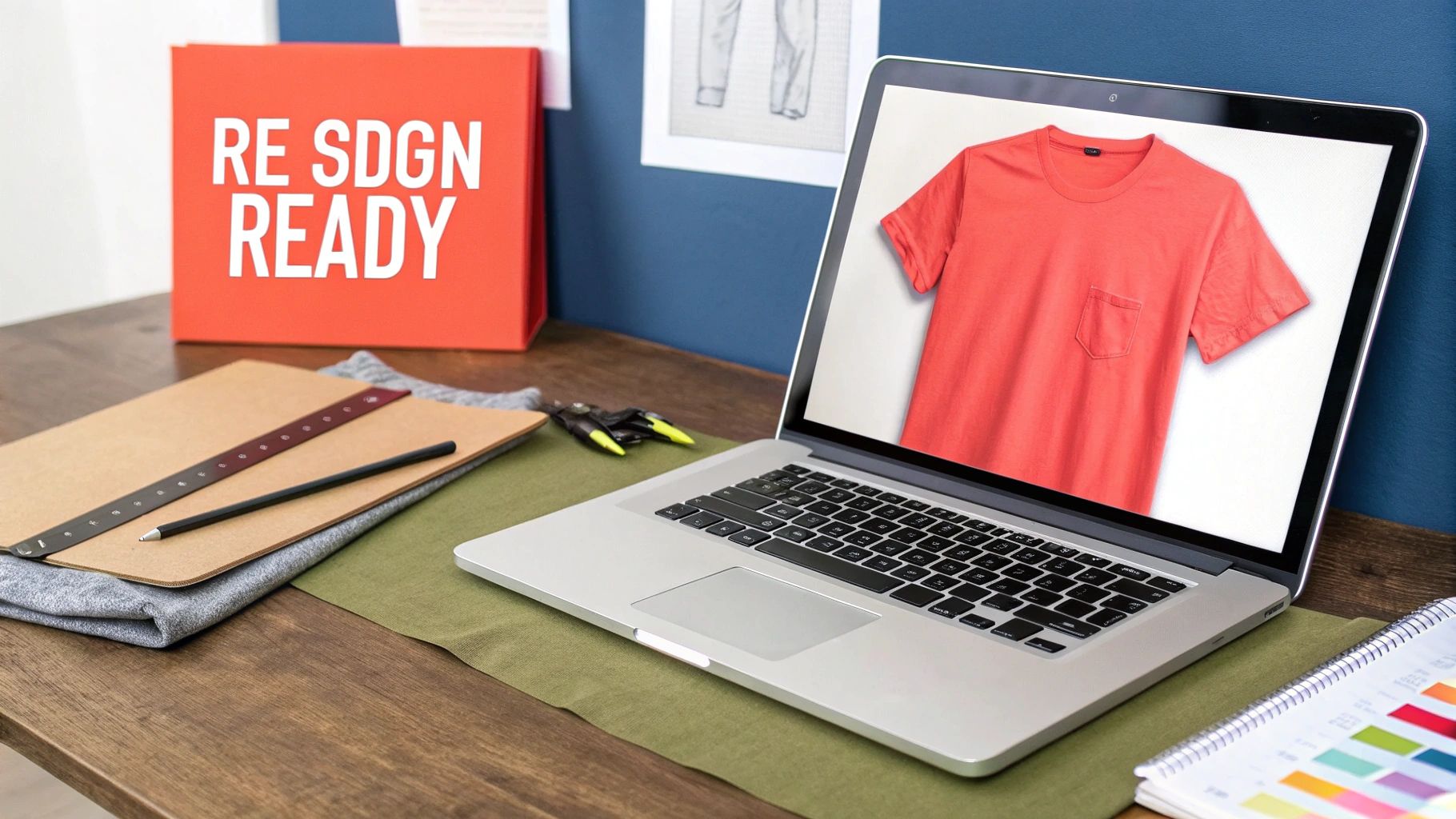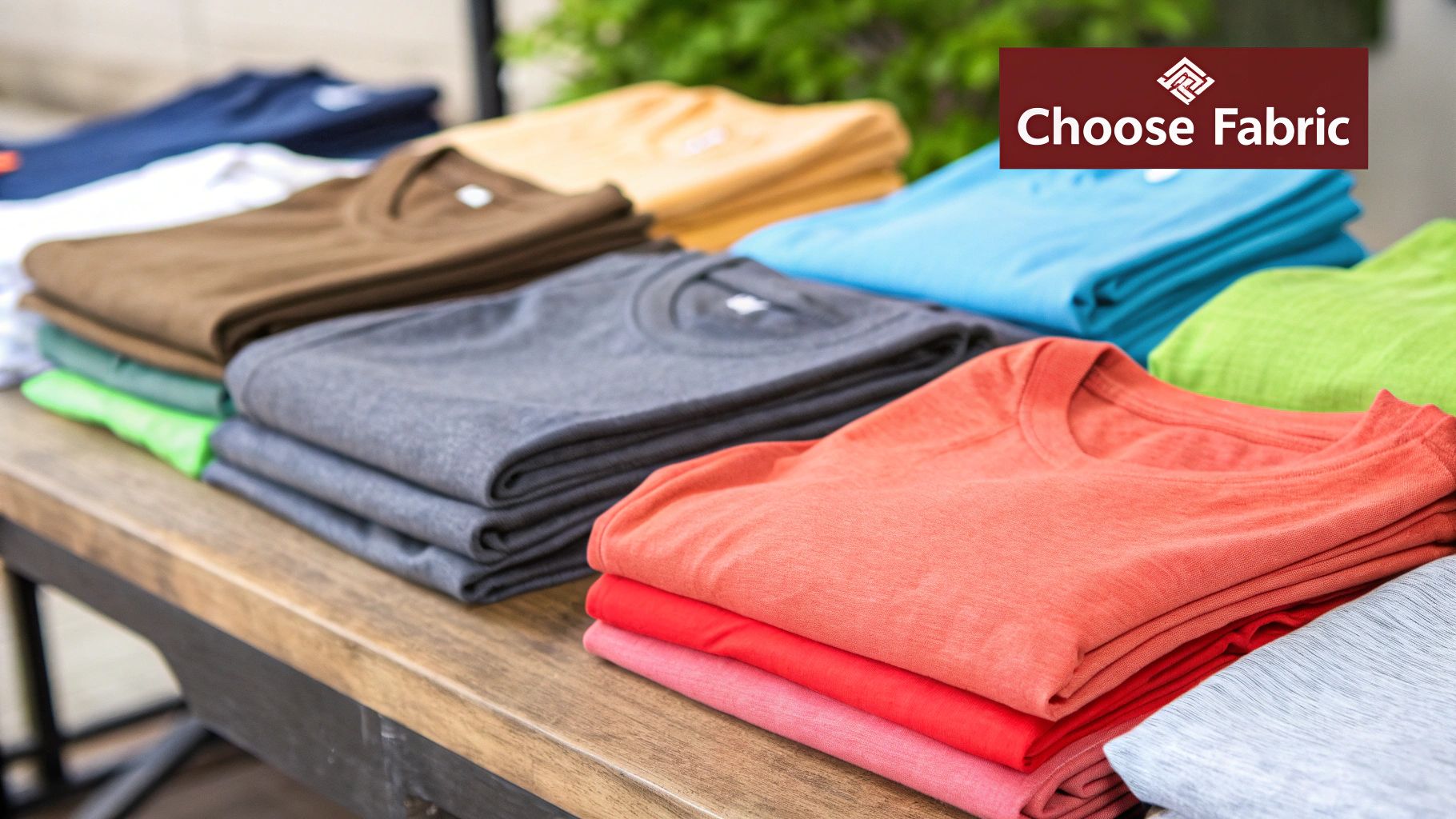The Art and Science of Custom Shirt Printing
Custom shirt printing has blossomed from a simple craft into a thriving industry. It offers a powerful way to blend personal expression with entrepreneurial spirit. This creative medium lets individuals wear their passions, beliefs, and even their sense of humor, transforming an ordinary shirt into a statement of individuality. For businesses, custom apparel is a key tool for branding, team building, and creating memorable merchandise. This intersection of creativity and commerce makes custom shirt printing a compelling field.
Why Custom Shirt Printing Matters
The growing desire for unique, personalized items fuels this industry's expansion. People want to stand out from the crowd and express themselves authentically. Custom shirts offer a tangible way to showcase interests, affiliations, and unique perspectives. The rise of social media has also amplified the visibility of custom apparel, further boosting its popularity and inspiring others to create and share their own designs.
The Market's Exponential Growth
This increasing demand is reflected in the market's impressive growth. The global custom t-shirt printing market reached a value of $5.16 billion in 2024. It's projected to grow at an 11.5% compound annual growth rate (CAGR) through 2030. This surge is fueled by advancements in digital printing technologies like Direct-to-Garment (DTG) printing and a shift towards on-demand designs. This trend is particularly evident in e-commerce and corporate branding. Even government initiatives, such as England’s £12 million 'Impact '25' rugby program, highlight how investments in sports contribute to the demand for custom merchandise. More detailed statistics are available from Grand View Research.
From Niche to Mainstream
Custom printing has evolved from a niche hobby to a mainstream phenomenon. Early methods were often cumbersome and messy, limiting accessibility. The arrival of user-friendly online platforms like Printful and sophisticated printing techniques has democratized the process. This empowers individuals and small businesses to easily create high-quality custom apparel, opening a world of possibilities for creative expression and entrepreneurial ventures. Now, creating and ordering custom shirts, from single items to large production runs, is within almost everyone's reach. This accessibility has been crucial to the industry's growth and continues to drive innovation.
Printing Techniques: Finding Your Perfect Method
Choosing the right printing technique is crucial for your custom shirt design. Each method has unique advantages and suits specific designs and project sizes. Let's explore popular techniques used by professional print shops.
Screen Printing: The Champion of Bulk Orders
Screen printing, also called silk screening, is known for its durability and vibrant colors. This technique pushes ink through a mesh screen onto the fabric. Each color needs a separate screen, making it cost-effective for large orders with simple designs. Think bold graphics, team logos, or simple text – these are where screen printing excels. For example, sports uniforms often use screen printing because it withstands repeated washes and keeps colors bright.
Direct-to-Garment (DTG) Printing: Detail-Oriented Designs
DTG printing is like an inkjet printer for fabric. It reproduces intricate designs with photographic detail and a wide color range. DTG is great for highly detailed designs, photorealistic prints, and designs with gradients or many colors. This technique is ideal for memorial shirts with detailed photographs or artistic designs with complex color blends. However, DTG printing is usually more expensive per item than screen printing, especially for smaller orders.
Heat Transfer Printing: Quick and Versatile
Heat transfer printing prints your design onto special transfer paper, then uses heat and pressure to transfer the image to the fabric. This method is versatile, working on various materials, and suits small batches or individual designs. For example, heat transfer is popular for personalized gifts or small-scale merchandise because it's fast. It's a good option for full-color images or small, detailed text.
Choosing the Right Technique: A Data-Driven Approach
Choosing the best printing method depends on your needs and budget. The following data chart visualizes key factors to consider when choosing between screen printing, DTG, and heat transfer:

As the chart shows, screen printing offers the lowest cost per item for large quantities, while DTG provides superior detail and color. Heat transfer is known for its quick turnaround, making it ideal for smaller projects. These factors, along with your budget and design complexity, will guide your decision.
To further help you choose, here's a table summarizing the key differences:
Comparison of Custom Shirt Printing Techniques
| Printing Technique | Best For | Cost Range | Durability | Color Vibrancy | Minimum Order |
|---|---|---|---|---|---|
| Screen Printing | Large orders, simple designs | Low | High | High | High |
| DTG | Complex designs, high detail | Moderate to High | Moderate | High | Low |
| Heat Transfer | Small orders, quick turnaround | Moderate | Moderate | Moderate | Low |
The custom t-shirt printing market is growing rapidly. It's projected to grow from $8.17 billion in 2024 to $9 billion in 2025, at a 10.2% CAGR. By 2029, it's expected to reach $13.55 billion, driven by personalization and athleisure trends. Learn more about custom t-shirt printing market growth. Screen printing remains dominant for bulk orders, but DTG is gaining popularity for its intricate design capabilities. You can also explore sitemaps for more information. Understanding these trends helps you make informed decisions about your custom shirt projects, optimizing both visual impact and cost-effectiveness.
Fabric Foundations: Choosing Materials That Perform
The success of your custom shirt printing project depends heavily on the fabric you choose. The material impacts both the wearer's comfort and how well the final print looks. Therefore, understanding the relationship between different fabrics and printing methods is crucial. You might be interested in: How to master product sitemaps.
Matching Material to Printing Method
Some fabrics take vibrant colors beautifully, while others may not be suitable for intricate designs. For instance, 100% cotton is a favorite for its softness and absorbency, making it perfect for Direct-to-Garment (DTG) printing. Direct-to-Garment printing is very popular these days. However, cotton's tendency to shrink can be a downside. On the other hand, polyester maintains its shape well and resists wrinkles, making it a good choice for activewear and screen printing Screen Printing. This adaptability makes polyester a versatile choice for custom apparel.
Understanding GSM and Fabric Blends
Knowing technical specs like Grams per Square Meter (GSM) helps you determine a fabric's weight and thickness. A higher GSM typically means a heavier, more durable fabric. A lightweight t-shirt might have a GSM of 150, while a heavier hoodie could be around 300.
Fabric blends combine the strengths of different materials. A 50/50 cotton-polyester blend, for example, provides both comfort and durability. This creates a well-balanced fabric suitable for various applications.
Exploring Sustainable Fabric Options
Beyond the usual choices, sustainable fabrics are becoming increasingly popular. Organic cotton, bamboo, and recycled polyester offer eco-conscious alternatives. These options appeal to environmentally aware customers and demonstrate a commitment to responsible production.
Balancing quality, sustainability, and cost is essential for picking the right fabric. Interestingly, the custom shirt printing market is projected to grow significantly, reaching $11.37 billion by 2035 with a 9.3% CAGR. This growth is partly fueled by the increasing demand for sustainable printing practices and the growing use of organic fabrics. Find more detailed statistics here.
Fabric Selection for Specific Use Cases
Always consider the shirt's intended use when choosing your fabric. Performance wear needs moisture-wicking materials, while everyday t-shirts prioritize comfort and breathability. Work uniforms, on the other hand, may require durable fabrics that can withstand frequent washing.
Considering Cost and Quality
Budget is always a consideration in custom shirt printing. While premium fabrics might have a higher initial cost, they often deliver better print results and last longer. This can make them more cost-effective in the long run. Finding the right balance ensures your design looks its best and provides lasting value.

Design Secrets: Creating Shirts People Actually Want

Turning your creative spark into a winning custom shirt design takes more than just a good eye. It's about understanding what resonates with people on a deeper level. This section explores the psychology of effective shirt designs and offers practical advice for creating shirts your audience will love.
Emotional Connection: Beyond Visuals
The most successful shirt designs forge an emotional connection with the wearer. A design that evokes a feeling, a memory, or a shared experience is far more likely to become a favorite. Think about shirts commemorating a favorite band, a memorable vacation, or a beloved pet. These designs tap into emotions, transforming a simple shirt into something much more.
Balancing Trends and Timeless Appeal
While trendy elements can give a design initial buzz, long-term success hinges on a balance of current styles and timeless appeal. A design that's too trendy might quickly feel outdated. Incorporating classic elements ensures the design remains relevant and wearable for years to come. This is especially important for custom shirt printing projects intended for long-term use or repeat sales.
Psychological Triggers in Design
Subtle design elements can significantly influence buying decisions. Color psychology, for instance, plays a crucial role. Bright colors can convey energy and excitement, while softer hues project tranquility. Similarly, using humor, nostalgia, or shared cultural references can create a strong connection with the wearer. These are important considerations during the design phase.
Avoiding Common Design Pitfalls
Several common mistakes can derail a design's success. Overly complex designs can look cluttered and lose their impact. Poor font choices or illegible text can make a design difficult to read and understand. And neglecting to consider the target audience's preferences can result in a design that simply misses the mark.
Troubleshooting Creative Blocks
Every designer encounters creative blocks from time to time. Overcoming these obstacles often involves stepping back from the project, seeking inspiration from other sources, or experimenting with new approaches. Sometimes, revisiting the core message or purpose of the design can rekindle the creative spark.
Choosing the Right Design Software
The right design software is essential for bringing your vision to life. Professional programs like Adobe Illustrator offer advanced features but can have a steeper learning curve. User-friendly options like Canva provide simpler tools ideal for beginners, enabling easy creation and customization. Affinity Designer sits comfortably in the middle, offering powerful features at a more affordable price point.
To help you choose the right software, we've put together a comparison table highlighting the key features, limitations, and ideal users for each option.
Design Software Options for Custom Shirt Design: A comparison of different design software options for creating custom shirt designs, from professional solutions to beginner-friendly tools.
| Software | Price Range | Difficulty Level | Best Features | Limitations | Ideal User |
|---|---|---|---|---|---|
| Adobe Illustrator | Subscription | Advanced | Vector graphics, precise control | Steeper learning curve | Professionals |
| Canva | Free/Subscription | Beginner | User-friendly interface, templates | Limited advanced features | Beginners, casual users |
| Affinity Designer | One-time purchase | Intermediate | Powerful features, affordable | Fewer resources than Adobe | Budget-conscious designers |
As you can see, each program offers a unique set of advantages and disadvantages. Choosing the right software depends on your skill level, budget, and design needs.
By understanding these design principles and choosing the right tools, you can create custom shirt printing projects that are not only visually appealing but also deeply meaningful and commercially successful.
DIY vs. Professional: Making the Smart Choice
Deciding between printing your custom shirts yourself or using a professional service is a key step in your custom apparel journey. This choice depends on factors like your budget, the complexity of your designs, and the number of shirts you need. Let's explore the pros and cons of each approach to help you make the informed decision.
The DIY Approach: Taking Control
The do-it-yourself (DIY) approach gives you complete control over the entire process. You choose the equipment, the materials, and every detail of the design. This hands-on approach can be incredibly rewarding, allowing for deep creative exploration and unique experimentation.
-
Benefits of DIY:
- Creative Freedom: Experiment with different techniques and push your design boundaries without any external limitations.
- Potential Cost Savings: For smaller projects, DIY can be more budget-friendly than professional services.
- Skill Development: Learn valuable printing skills and gain a deeper understanding of the process.
-
Challenges of DIY:
- Initial Investment: Equipment costs can be significant, especially for methods like screen printing.
- Learning Curve: Mastering printing techniques takes time, patience, and there's always the potential for errors.
- Time Commitment: DIY printing is time-consuming, requiring setup, printing, and cleanup.
The Professional Route: Expertise and Efficiency
Partnering with a professional custom shirt printing service brings expertise and efficiency to your project. These services have the necessary equipment, experience, and streamlined workflows to handle projects of all sizes, from single shirts to large bulk orders.
-
Benefits of Professional Services:
- High-Quality Results: Professionals produce consistent, high-quality prints using advanced equipment.
- Time Savings: Leave the printing to the experts and focus on your design and other aspects of your business or project.
- Scalability: Easily scale up production as your needs grow, without investing in more equipment.
-
Challenges of Professional Services:
- Cost: Professional services can be more expensive than DIY, especially for smaller orders.
- Communication: Clearly conveying your design vision and ensuring the printer understands your needs is critical. A solid design feedback process is essential.
- Finding the Right Partner: Choosing a reputable and reliable printing service that aligns with your values is important.
The Hybrid Approach: Balancing Control and Convenience
A hybrid approach combines the best aspects of DIY and professional services. You might handle the design and pre-press work yourself and then outsource the actual printing to a professional. Or, you might invest in a heat press) for smaller projects while relying on professionals for larger orders. This allows for a flexible balance of control and convenience.
Making the Right Choice
Ultimately, the best approach depends on your individual circumstances. Consider factors like your budget, design complexity, the quantity of shirts you need, and your available time. If you’re just starting out and want to test the waters, DIY might be suitable for small batches. As your volume increases or designs become more intricate, consider professional help.

Evolving Your Strategy
Your chosen approach isn't permanent. As your skills develop and your needs change, you can shift from DIY to professional services, or vice versa. Stay adaptable and re-evaluate your printing process periodically to optimize for efficiency and quality. For example, if you begin with DIY and find the process too time-consuming, consider outsourcing to free up your time. Remember, the goal is to produce high-quality custom shirts efficiently and cost-effectively.
Launching Your Custom Shirt Printing Business
So, you dream of turning your passion for custom shirt printing into a thriving business? This section goes beyond the basics, exploring how to build a successful and sustainable apparel brand in today's competitive market.
Strategic Equipment Investment
Choosing the right equipment is paramount. Starting with versatile, budget-friendly options can save you from unnecessary upgrades down the line. A quality heat press paired with a wide-format inkjet printer can handle a surprising variety of projects without emptying your wallet.
As your business grows, strategically add specialized equipment like a DTG printer for intricate designs or a screen printing setup for bulk orders. Careful planning maximizes your return on investment and prevents costly missteps.
Pricing for Profit
Pricing is crucial for your bottom line. Research your competitors to understand current market prices. Factor in all your costs – materials, labor, and overhead – to determine your profit margin.
Consider offering tiered pricing based on order size or design complexity. This gives customers options while ensuring your profitability across different project types.
Production Workflows That Scale
Efficient workflows are key to handling growth. Optimize every step, from order placement to printing and shipping. Investing in order management software can help track inventory and automate tasks.
This keeps production running smoothly and efficiently, even as your business expands.
Identifying Your Niche
In a crowded marketplace, finding your niche is essential. This might involve specializing in a particular printing technique, targeting a specific demographic, or developing a signature design style.
Focusing on eco-friendly printing and sustainable materials, for instance, can attract environmentally conscious customers. Specializing in band merchandise or custom pet apparel could tap into passionate communities. Read also: Explore sitemaps for more category inspiration.
Developing Signature Techniques
Developing signature techniques differentiates your brand. Experiment with unique printing methods, create your own design templates, or offer specialized finishing options.
These distinctive touches become a hallmark of your brand, attracting customers looking for something special.
Building Customer Loyalty
Repeat business is the lifeblood of any successful business. A strong customer loyalty program fosters a sense of community and encourages repeat orders.
Offer discounts to returning customers, create exclusive deals, and engage with your audience on social media platforms. This builds relationships and turns one-time buyers into loyal fans.
Case Studies: Learning From Success
Studying established printing businesses offers valuable lessons. Analyze their business models, marketing approaches, and production processes. Identify their differentiating factors and consider how those lessons apply to your own venture. Learning from others' successes can accelerate your growth and help you avoid common mistakes.
Launching a successful custom shirt printing business takes more than just equipment and designs. It requires strategic thinking, a clear vision, and a commitment to building a sustainable brand. By focusing on these key strategies, you can create a thriving business that stands out from the competition and delivers exceptional custom apparel.
Ready to bring your creative vision to life? Design and order your unique custom shirts at ThisShirtExists.com today! Let our AI-powered platform help you create unforgettable, personalized gifts.


